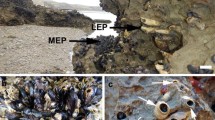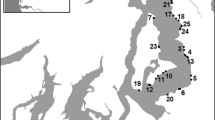Abstract
Ecosystem engineering is an important process in a variety of ecosystems. However, the relationship between engineer density and engineering impact remains poorly understood. We used experiments and a mathematical model to examine the role of engineer density in a rocky intertidal community in northern California. In this system, the whelk Nucella ostrina preys on barnacles (Balanus glandula and Chthamalus dalli), leaving empty barnacle tests as a resource (favorable microhabitat) for other species. Field experiments demonstrated that N. ostrina predation increased the availability of empty tests of both barnacle species, reduced the density of the competitively dominant B. glandula, and indirectly increased the density of the competitively inferior C. dalli. Empty barnacle tests altered microhabitat humidity, but not temperature, and presumably provided a refuge from wave action. The herbivorous snail Littorina plena was positively associated with empty test availability in both observational comparisons and experimental manipulations of empty test availability, and L. plena density was elevated in areas with foraging N. ostrina. To explore the effects of variation in N. ostrina predation, we constructed a demographic matrix model for barnacles in which we varied predation intensity. The model predicted that number of available empty tests increases with predation intensity to a point, but declines when predation pressure was strong enough to severely reduce adult barnacle densities. The modeled number of available empty tests therefore peaked at an intermediate level of N. ostrina predation. Non-linear relationships between engineer density and engineer impact may be a generally important attribute of systems in which engineers influence the population dynamics of the species that they manipulate.






Similar content being viewed by others
References
Barnes M (2000) The use of intertidal barnacle shells. Oceanogr Mar Biol Annu Rev 38:157–187
Baxter PWJ, Getz WM (2005) A model-framed evaluation of elephant effects on tree and fire dynamics in African Savannas. Ecol Appl 15:1331–1341
Behrens Yamada S, Boulding EG (1996) The role of highly mobile crab predators in the intertidal zonation of their gastropod prey. J Exp Mar Biol Ecol 204:59–83
Bertness MD, Leonard GH, Levine JM, Schmidt PR, Ingraham AO (1999) Testing the relative contribution of positive and negative interactions in rocky intertidal communities. Ecology 80:2711–2726
Carriker MR (1981) Shell penetration and feeding by naticacean and muricacean predatory gastropods: a synthesis. Malacologia 20:403–422
Castilla JC, Lagos NA, Cerda M (2004) Marine ecosystem engineering by the alien ascidian Pyura praeputialis on a mid-intertidal rocky shore. Mar Ecol Prog Ser 268:119–130
Chow V (1989) Intraspecific competition in a fluctuating population of Littorina plena Gould (Gastropoda, Prosobranchia). J Exp Mar Biol Ecol 130:147–165
Connell JH (1961) The influence of interspecific competition and other factors on the distribution of the barnacle Chthamalus stellatus. Ecology 42:710–723
Connell JH (1970) A predator prey system in the marine intertidal region. I. Balanus glandula and several predatory species of Thais. Ecol Monogr 40:49–78
Connolly SR, Menge BA, Roughgarden J (2001) A latitudinal gradient in recruitment of intertidal invertebrates in the Northeast Pacific Ocean. Ecology 82:1799–1813
Dayton PK (1971) Competition, disturbance, and community organization: the provision and subsequent utilization of space in a rocky intertidal community. Ecol Monogr 41:351–389
Emson RH, Faller-Fritsch RJ (1976) An experimental investigation into the effect of crevice availability on abundance and size-structure in a population of Littorina rudis (Maton): Gastropoda: Prosobranchia. J Exp Mar Biol Ecol 23:285–297
Faller-Fritsh RJ, Emson RH (1985) Causes and patterns of mortality in Littorina rudis (Maton) in relation to intraspecific variation: a review. In: Moore PG, Seed R (eds) The ecology of rocky coasts. Hodder and Stoughton, London, pp 157–177
Farrell TM, Bracher D, Roughgarden J (1991) Cross-shelf transport causes recruitment to intertidal populations in central California. Limnol Oceanogr 36:279–288
Gaines SD, Roughgarden J (1985) Larval settlement rate: a leading determinant of structure in an ecological community of the marine intertidal zone. Proc Natl Acad Sci USA 82:3707–3711
Glynn PW (1965) Community composition, structure, and interrelationships in the marine intertidal Endocladia muricata–Balanus glandula association in Monterey Bay, California. Beaufortia 12:1–198
Gosselin LA, Bourget E (1989) The performance of an intertidal predator Thais lapillus, in relation to structural heterogeneity. J Anim Ecol 58:287–303
Gosselin LA, Chia FS (1994) Feeding habits of newly hatched juveniles of an intertidal predatory gastropod, Nucella emarginata (Deshayes). J Exp Mar Biol Ecol 176:1–13
Gosselin LA, Qian P (1996) Early post-settlement mortality of an intertidal barnacle: a critical period for survival. Mar Ecol Prog Ser 135:69–75
Harley CDG (2003) Species importance and context: spatial and temporal variation in species interactions. In: Kareiva P, Levin SA (eds) The importance of species: perspectives on expendability and triage. Princeton University Press, Princeton, pp 44–68
Harley CDG (2006) Effects of physical ecosystem engineering and herbivory on intertidal community structure. Mar Ecol Prog Ser 317:29–39
Harley CDG (2008) Tidal dynamics, topographic orientation, and temperature-mediated mass mortalities on rocky shores. Mar Ecol Prog Ser 371:37–46
Harley CDG, Lopez JP (2003) The natural history, thermal physiology, and ecological impacts of the intertidal mesopredators, Oedoparena spp. (Diptera: Dryomyzidae). Invertebr Biol 122:61–73
Hatton JC, Smart NOE (1984) The effect of long-term exclusion of large herbivores on soil nutrient status in Murchison Falls National Park, Uganda. J Afr Ecol 22:23–30
Hayworth AM, Quinn JF (1990) Temperature of limpets in the rocky intertidal zone: effects of caging and substratum. Limnol Oceanogr 35:967–970
Hutchings PA (1986) Biological destruction of coral reefs. Coral Reefs 4:239–252
Ivlev VS (1961) Experimental ecology of the feeding of fishes. Yale University Press, New Haven
Jernakoff P (1986) Experimental investigation of interactions between the perennial red alga Gelidium pusillum and barnacles on a New South Wales rocky shore. Mar Ecol Prog Ser 28:259–263
Jones KMM, Boulding EG (1999) State-dependent habitat selection by an intertidal snail: the costs of selecting a physically stressful microhabitat. J Exp Mar Biol Ecol 242:149–177
Jones CG, Lawton JH, Shachak M (1994) Organisms as ecosystem engineers. Oikos 69:373–386
Jones CG, Lawton JH, Shachak M (1997) Positive and negative effects of organisms as physical ecosystem engineers. Ecology 78:1946–1957
Kimbro DL, Grosholz ED (2006) Disturbance influences oyster community richness and evenness, but not diversity. Ecology 87:2378–2388
Laws RM (1970) Elephants as agents of habitat and landscape change in East Africa. Oikos 21:1–15
Lawton JH, Beddington JR, Bonser R (1974) Switching in invertebrate predators. In: Usher MB, Williamson MH (eds) Ecological stability. Chapman and Hall, London, pp 141–158
Lenihan HS, Peterson CH (1998) How habitat degradation through fishery disturbance enhances impacts of hypoxia on oyster reefs. Ecol Appl 8:128–140
Lubchenco J (1978) Plant species diversity in a marine intertidal community: importance of herbivore preference and algal competitive abilities. Am Nat 112:23–39
McCormack SMD (1982) The maintenance of shore-level size gradients in an intertidal snail (Littorina sitkana). Oecologia 54:177–183
Orrock JL, Fletcher RJ Jr (2005) Changes in community size affect the outcome of competition. Am Nat 166:107–111
Palmer AR (1983) Growth rate as a measure of food value in thaidid gastropods: assumptions and implications for prey morphology and distribution. J Exp Mar Biol Ecol 73:95–124
Peterson CH, Bradley BP (1978) Estimating diet of a sluggish predator from field observations. J Fish Res Board Can 35:136–141
Ruesink JL (1998) Variation in per capita interaction strength: thresholds due to nonlinear dynamics and nonequilibrium conditions. Proc Natl Acad Sci USA 95:6843–6847
Schoppe S, Werding B (1996) The boreholes of the sea urchin genus Echinometra (Echinodermata: Echinoidea: Echinometridae) as a microhabitat in tropical South America. Mar Ecol Publ Sta Zool Napoli I 17:181–186
Schubart CD, Basch LV, Miyasato G (1995) Recruitment of Balanus glandula Darwin (Crustacea: Cirripedia) into empty barnacle tests and its ecological consequences. J Exp Mar Biol Ecol 186:143–181
Seed R, Suchanek TH (1992) Population and community ecology of Mytilus. The mussel Mytilus: ecology, physiology, genetics, and culture. In: Gosling E (ed) The mussel Mytilus: ecology, physiology, genetics, and culture. Elsevier, Amsterdam, pp 87–169
Wieters EA, Navarrete SA (1998) Spatial variability in prey preferences of the intertidal whelks Nucella canaliculata and Nucella emarginata. J Exp Mar Biol Ecol 222:133–148
Acknowledgments
We thank the Bodega Marine Laboratory for facilitating this work and providing us with space, equipment, and access to field sites. J. Clegg, A. Newsom, and S. Williams provided invaluable support, assistance, and advice. L. Miller kindly provided the cages used in the N. ostrina exclusion experiment. Constructive criticisms by E. Sanford and two anonymous reviewers improved the manuscript. J.O. was supported by a Research Experience for Undergraduates Fellowship (U.S. National Science Foundation Grant # DBI0453251), and C.H. was supported by BML institutional funds and a Canadian National Science and Engineering Research Council Discovery Grant. This paper is a contribution of the Bodega Marine Laboratory, University of California at Davis. The research described in this paper complies with the current laws of the United States and Canada.
Author information
Authors and Affiliations
Corresponding author
Additional information
Communicated by Pete Peterson.
Rights and permissions
About this article
Cite this article
Harley, C.D.G., O’Riley, J.L. Non-linear density-dependent effects of an intertidal ecosystem engineer. Oecologia 166, 531–541 (2011). https://doi.org/10.1007/s00442-010-1864-1
Received:
Accepted:
Published:
Issue Date:
DOI: https://doi.org/10.1007/s00442-010-1864-1




